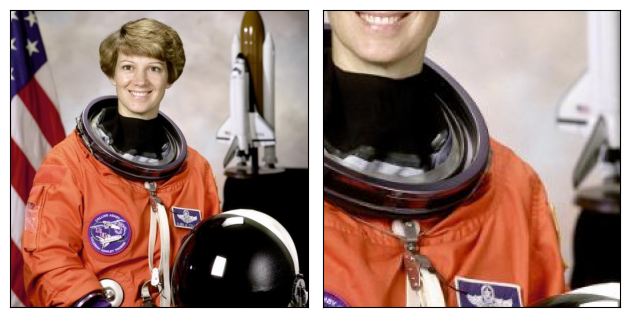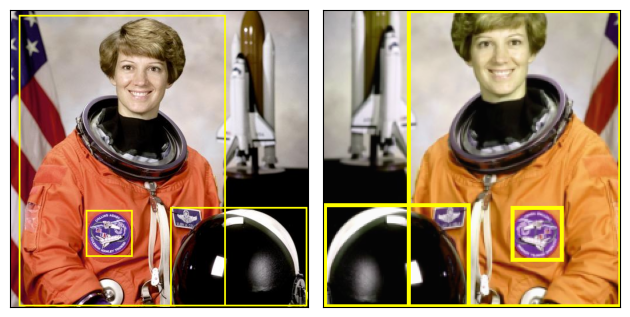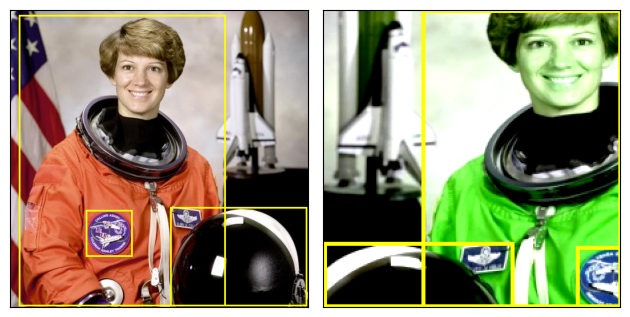Getting started with transforms v2¶
Note
Try on Colab or go to the end to download the full example code.
This example illustrates all of what you need to know to get started with the
new torchvision.transforms.v2 API. We’ll cover simple tasks like
image classification, and more advanced ones like object detection /
segmentation.
First, a bit of setup
from pathlib import Path
import torch
import matplotlib.pyplot as plt
plt.rcParams["savefig.bbox"] = 'tight'
from torchvision.transforms import v2
from torchvision.io import decode_image
torch.manual_seed(1)
# If you're trying to run that on Colab, you can download the assets and the
# helpers from https://github.com/pytorch/vision/tree/main/gallery/
from helpers import plot
img = decode_image(str(Path('../assets') / 'astronaut.jpg'))
print(f"{type(img) = }, {img.dtype = }, {img.shape = }")
type(img) = <class 'torch.Tensor'>, img.dtype = torch.uint8, img.shape = torch.Size([3, 512, 512])
The basics¶
The Torchvision transforms behave like a regular torch.nn.Module (in
fact, most of them are): instantiate a transform, pass an input, get a
transformed output:
transform = v2.RandomCrop(size=(224, 224))
out = transform(img)
plot([img, out])

I just want to do image classification¶
If you just care about image classification, things are very simple. A basic classification pipeline may look like this:
transforms = v2.Compose([
v2.RandomResizedCrop(size=(224, 224), antialias=True),
v2.RandomHorizontalFlip(p=0.5),
v2.ToDtype(torch.float32, scale=True),
v2.Normalize(mean=[0.485, 0.456, 0.406], std=[0.229, 0.224, 0.225]),
])
out = transforms(img)
plot([img, out])

Such transformation pipeline is typically passed as the transform argument
to the Datasets, e.g. ImageNet(...,
transform=transforms).
That’s pretty much all there is. From there, read through our main docs to learn more about recommended practices and conventions, or explore more examples e.g. how to use augmentation transforms like CutMix and MixUp.
Note
If you’re already relying on the torchvision.transforms v1 API,
we recommend to switch to the new v2 transforms. It’s
very easy: the v2 transforms are fully compatible with the v1 API, so you
only need to change the import!
Detection, Segmentation, Videos¶
The new Torchvision transforms in the torchvision.transforms.v2 namespace
support tasks beyond image classification: they can also transform bounding
boxes, segmentation / detection masks, or videos.
Let’s briefly look at a detection example with bounding boxes.
from torchvision import tv_tensors # we'll describe this a bit later, bare with us
boxes = tv_tensors.BoundingBoxes(
[
[15, 10, 370, 510],
[275, 340, 510, 510],
[130, 345, 210, 425]
],
format="XYXY", canvas_size=img.shape[-2:])
transforms = v2.Compose([
v2.RandomResizedCrop(size=(224, 224), antialias=True),
v2.RandomPhotometricDistort(p=1),
v2.RandomHorizontalFlip(p=1),
])
out_img, out_boxes = transforms(img, boxes)
print(type(boxes), type(out_boxes))
plot([(img, boxes), (out_img, out_boxes)])

<class 'torchvision.tv_tensors._bounding_boxes.BoundingBoxes'> <class 'torchvision.tv_tensors._bounding_boxes.BoundingBoxes'>
The example above focuses on object detection. But if we had masks
(torchvision.tv_tensors.Mask) for object segmentation or semantic
segmentation, or videos (torchvision.tv_tensors.Video), we could have
passed them to the transforms in exactly the same way.
By now you likely have a few questions: what are these TVTensors, how do we use them, and what is the expected input/output of those transforms? We’ll answer these in the next sections.
What are TVTensors?¶
TVTensors are torch.Tensor subclasses. The available TVTensors are
Image,
BoundingBoxes,
Mask, and
Video.
TVTensors look and feel just like regular tensors - they are tensors.
Everything that is supported on a plain torch.Tensor like .sum()
or any torch.* operator will also work on a TVTensor:
img_dp = tv_tensors.Image(torch.randint(0, 256, (3, 256, 256), dtype=torch.uint8))
print(f"{isinstance(img_dp, torch.Tensor) = }")
print(f"{img_dp.dtype = }, {img_dp.shape = }, {img_dp.sum() = }")
isinstance(img_dp, torch.Tensor) = True
img_dp.dtype = torch.uint8, img_dp.shape = torch.Size([3, 256, 256]), img_dp.sum() = tensor(25087958)
These TVTensor classes are at the core of the transforms: in order to transform a given input, the transforms first look at the class of the object, and dispatch to the appropriate implementation accordingly.
You don’t need to know much more about TVTensors at this point, but advanced users who want to learn more can refer to TVTensors FAQ.
What do I pass as input?¶
Above, we’ve seen two examples: one where we passed a single image as input
i.e. out = transforms(img), and one where we passed both an image and
bounding boxes, i.e. out_img, out_boxes = transforms(img, boxes).
In fact, transforms support arbitrary input structures. The input can be a single image, a tuple, an arbitrarily nested dictionary… pretty much anything. The same structure will be returned as output. Below, we use the same detection transforms, but pass a tuple (image, target_dict) as input and we’re getting the same structure as output:
target = {
"boxes": boxes,
"labels": torch.arange(boxes.shape[0]),
"this_is_ignored": ("arbitrary", {"structure": "!"})
}
# Re-using the transforms and definitions from above.
out_img, out_target = transforms(img, target)
plot([(img, target["boxes"]), (out_img, out_target["boxes"])])
print(f"{out_target['this_is_ignored']}")

('arbitrary', {'structure': '!'})
We passed a tuple so we get a tuple back, and the second element is the tranformed target dict. Transforms don’t really care about the structure of the input; as mentioned above, they only care about the type of the objects and transforms them accordingly.
Foreign objects like strings or ints are simply passed-through. This can be useful e.g. if you want to associate a path with every single sample when debugging!
Note
Disclaimer This note is slightly advanced and can be safely skipped on a first read.
Pure torch.Tensor objects are, in general, treated as images (or
as videos for video-specific transforms). Indeed, you may have noticed
that in the code above we haven’t used the
Image class at all, and yet our images
got transformed properly. Transforms follow the following logic to
determine whether a pure Tensor should be treated as an image (or video),
or just ignored:
If there is an
Image,Video, orPIL.Image.Imageinstance in the input, all other pure tensors are passed-through.If there is no
ImageorVideoinstance, only the first puretorch.Tensorwill be transformed as image or video, while all others will be passed-through. Here “first” means “first in a depth-wise traversal”.
This is what happened in the detection example above: the first pure
tensor was the image so it got transformed properly, and all other pure
tensor instances like the labels were passed-through (although labels
can still be transformed by some transforms like
SanitizeBoundingBoxes!).
Transforms and Datasets intercompatibility¶
Roughly speaking, the output of the datasets must correspond to the input of the transforms. How to do that depends on whether you’re using the torchvision built-in datatsets, or your own custom datasets.
Using built-in datasets¶
If you’re just doing image classification, you don’t need to do anything. Just
use transform argument of the dataset e.g. ImageNet(...,
transform=transforms) and you’re good to go.
Torchvision also supports datasets for object detection or segmentation like
torchvision.datasets.CocoDetection. Those datasets predate
the existence of the torchvision.transforms.v2 module and of the
TVTensors, so they don’t return TVTensors out of the box.
An easy way to force those datasets to return TVTensors and to make them
compatible with v2 transforms is to use the
torchvision.datasets.wrap_dataset_for_transforms_v2() function:
from torchvision.datasets import CocoDetection, wrap_dataset_for_transforms_v2
dataset = CocoDetection(..., transforms=my_transforms)
dataset = wrap_dataset_for_transforms_v2(dataset)
# Now the dataset returns TVTensors!
Using your own datasets¶
If you have a custom dataset, then you’ll need to convert your objects into the appropriate TVTensor classes. Creating TVTensor instances is very easy, refer to How do I construct a TVTensor? for more details.
There are two main places where you can implement that conversion logic:
At the end of the datasets’s
__getitem__method, before returning the sample (or by sub-classing the dataset).As the very first step of your transforms pipeline
Either way, the logic will depend on your specific dataset.
Total running time of the script: (0 minutes 0.797 seconds)
